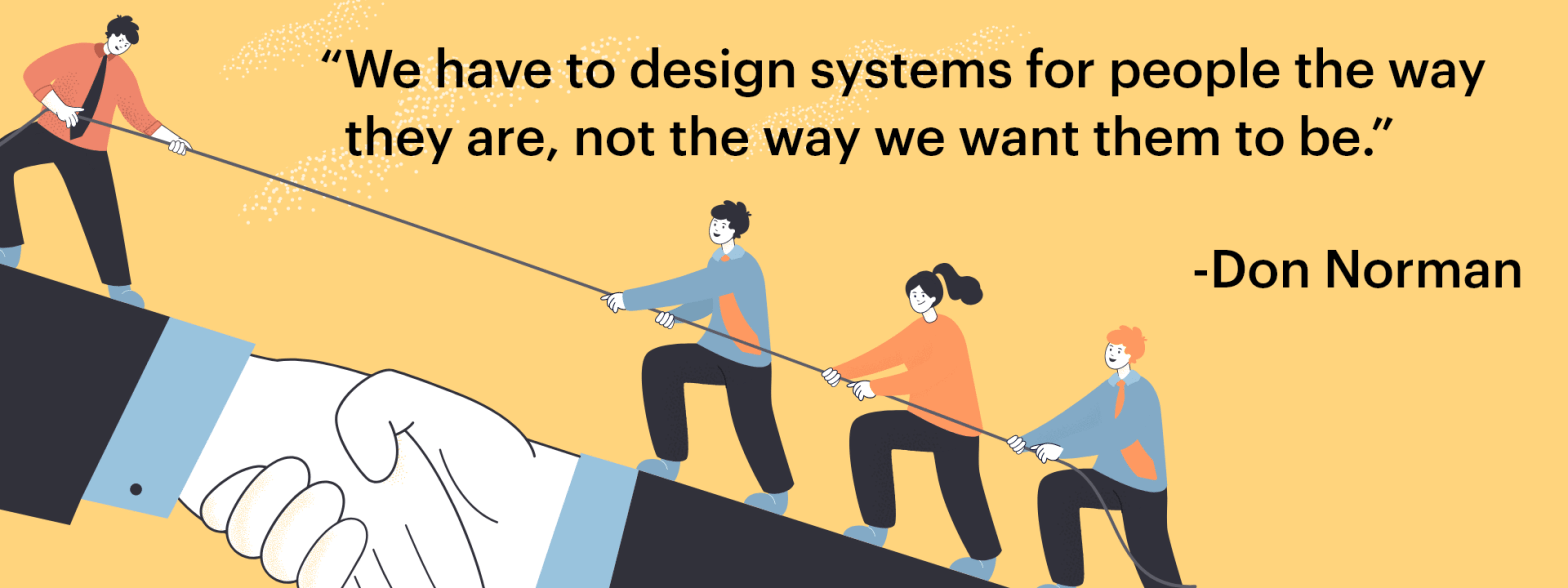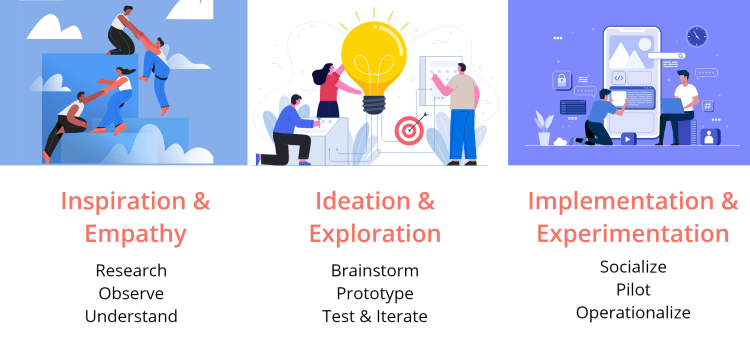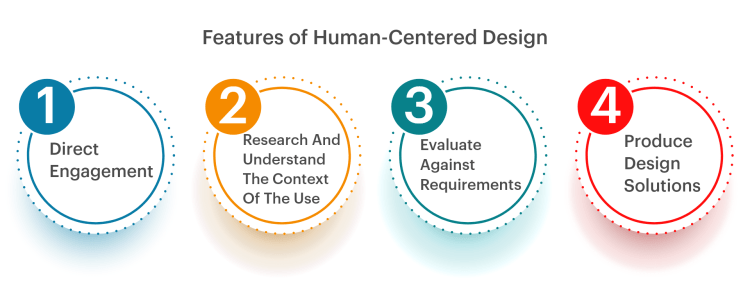
Perks of Human-Centered Design
![]() Taru M.
Taru M.
Published: 26 Aug, 2022
You have realized that senior adults in your area find it difficult to buy groceries and cook food for themselves. You decided to build a grocery and food delivery mobile application that will cater to their needs. After collaborating with a couple of restaurants and grocery stores in your area—you developed and designed the application (or hired someone to do it for you).
Table of contents
1. What is Human-Centered Design?
2. What are the 3 phases of Human Centered Design process?
After the mobile application launch, you realize that the senior adults are not using your application and are still facing the difficulties you intended to solve for them. But why?
A major reason products fail despite having a need and market demand is that, as a product owner/developer of the application, you were not empathetic enough towards your target consumers. This application would have proved admirable if the developers and designers had been more conscious and human-centric in their approach.
Building any product requires value-driven teams. Suppose you want to develop a good health app. Then it is imperative to partner with a good mobile app development company that understands the enormous significance of practicing human-centered design.
What is Human-Centered Design?

The need for a human-centered design approach was everpresent but rarely addressed. Given the velocity with which human civilization is growing in the technological realm, the demand for Human-Centric Design has increased manifolds.
Human-Centered Design, in essence, means to design from people’s perspectives. Doing this renders a creative and innovative approach to problem-solving. This design methodology might also lead to unexpected fruitful results.
In Human Centered Design, the designer keeps the consumer at the center of the designing process. Doing so ensures that the final product you create and deliver has contextual and long-term value to your users. ‘Always think of users’ should be a designer’s mantra; this is because when the users’ needs, problems, and pain are kept at the center of the developing and design process, it becomes more intuitive and operative for the customer.
Thinking from a user’s perspective, developers and designers might come up with a product, aka a solution for a problem that people weren’t even aware of in the first place—but somehow, it will make their lives easier.
What are the 3 phases of Human Centered Design process?
IDEO, the pioneer of designing, introduced and popularized three phases of Human Centered Design process.
Phase 1-Inspiration
This phase entails a lot of learning and on-ground research. If you have as many ideas in your mind and believe they would be extremely helpful for the targeted consumer base, stepping into your prospective customers’ shoes is vital to understanding their actual needs and problems.
Let’s take the example of the grocery and food delivery application we discussed above; despite the application developer having an excellent idea, they failed because they did not engage with the target consumers to understand their problems truly.
‘Identifying the need’ will not help you add value to your product. To truly add value, one has to step into the user’s shoes to understand the root cause of the problem. As a product designer/developer, you must have a creative process but, at the same time, conduct thorough research, observe, and understand what makes your users happy and sad.
There are many ways you can conduct research to understand the user’s point of view:
- conduct surveys
- ask your target users to fill out a questionnaire
- conduct focus group discussions
- take interviews
Choose a research method that is best suitable to your target user and the one that will yield you the most accurate results. For a customer base of senior adults, you can conduct focus group discussions (where everyone can discuss the problems they face in buying groceries or cooking food for themselves), or you can conduct face-to-face interviews.
Employing such methodologies might reveal unexpected necessities for senior adults—they might also need a service where they can buy medicines along with the other two services. Difficulty in comprehending minuscule application interfaces could be another significant point that might come up at this stage. Other than this, one primary concern for users with chronic health problems would be the nutritional specifications and factors of the delivered food.
After completing your research, you (together with your team) make a list of all the fundamental problems and critical areas where you can work. This will provide a larger framework or outline of the things based on which you can begin and make your work stand out.
Essentially, you must be as grounded as possible to recognize the users’ desires and move on to the next phase.
Phase 2- Ideation
This phase is all about brainstorming, prototyping, testing, and iterating. After you have conducted in-depth research with your target consumer and have a rough outline of problems faced by the users, you can begin brainstorming the ideas and visions that come to your mind.
In this step, there are no such things as good or bad ideas. Whatever ideas or solutions come to your mind, note those down, and keep refining and tweaking the ideas until you reach a satisfactory solution to the customer’s problem.
Phase 1 revealed that a single platform that delivers groceries, medicines, and food with an effortless interface and offers customized food options as per their medical needs would solve significant problems for senior adults.
Your starting point as a product owner could be identifying delivery partners and suppliers who can supply groceries and medicines. After that, you would need to get in touch with prospective restaurants and food joints that deliver medically customized food or would be willing to customize food as per your users’ requirements.
Simultaneously, product owners may start building a prototype or a Minimum Viable Product. It could be as simple as preparing a cardboard sample display of essential interface features you plan to implement in your final product.
Begin testing this prototype among your target users and keep planning, designing, developing, testing, deploying, and reviewing the product using agile methodologies.
The employment of a human-centered design approach compels the product designer or developer to really delve into their customers’ problems and needs. The ideation phase lays the foundation for the next phase, which is Implementation.
Phase 3- Implementation
After extensive research and ideation, the product owner is ready to release the product to a larger audience. Test essential features first via your prototype within a fixed set of stakeholders. Prepare an achievable action plan within a set timeline and resources (be economical).
Networking and building mechanisms are significant to this phase; otherwise, all the research and prototyping would yield no results. Even at this step, you must be solicitous regarding your marketing approach. Ask—what would be the best communication mediums to reach your target audience? How would you want to learn about the product if you were in their position?
In this phase, a product owner assimilates techniques to scale up and exhibit their product in the community. Hence, at this step, you can start socializing with fellow industry professionals, piloting your prototypes, and operationalizing to scale up your services.
As a product owner, you can also partner up with industries, product owners, developers, or marketing personas who offer similar products/services as yours or can help you expand.
Features of Human-Centered Design

The use of the word ‘human’ in Human-Centered Design instead of user-centered design is crucial, for the use of the term ‘human’ evokes the humanization of the design process. This humanization promotes empathy and a better understanding of the customers’ situation, needs, and behavior.
As discussed in the above hypothetical example, where the product designer wished to develop a mobile application for the elderly—they failed in their first attempt because it lacked empathy, but practicing human-centered design will make them acquainted with as many ideas and arenas which they wouldn’t have thought about otherwise.
Certain essential features make Human-Centered design thinking a worthwhile approach. Let’s discuss them:
-
Direct Engagement
Direct engagement with the final user is an exceptionally significant feature of the humanized design thinking approach that enables designers and developers to co-design. Meticulous research, understanding, interaction, observation, and evaluation of the customer base you wish to target as a product owner is extremely important as it helps you to dig deeper into the users’ problems.
A product owner/developer/designer has to keep in mind that they are building products for people to meet their needs and solve their complex problems. Therefore, direct engagement becomes vitally crucial here.
-
Research and understand the context of the use
This feature compels designers to visualize and give insights into how the product will actually be put to use in the community. Understanding the context of use helps get out of the perception of the product we are designing. Developers and owners often tend to reflect on their situation while building the product—which might be completely different from the users’ situation.
Continuing the above example, after you have launched an app that delivers medicines, groceries, and food (as per medical requirements) for the elderly, and now you wish to cater a similar application for professional young adults—you will have to understand the context of the use of the application as per their (professional young adults) needs and problems.
You will have to redefine your systems and techniques as a developer or designer. Therefore, the main focus should be on the final users’ suitability, not the ones we assume.
-
Evaluate against requirements
Usability evaluations are an extremely important tool. Testing the usability of the product will enable the designer to analyze whether the developed product is actually aiding the users with their needs and problems.
Product evaluation might reveal that you will have to restart from scratch (it might be because you did not understand the context of use) or might require you to make minor tweaks before launching the product.
-
Produce Design Solutions
Focusing only on evaluation and failing to deliver or add value to the prototype is not a wise way to operate. Removing the unwanted aspects will yield no results, instead would prove to be wasteful in terms of your time and effort.
Building and experimenting with multiple prototypes early in the development stage. Designers can also conduct experiments on users with different needs than the rest, and this will render a much better understanding of the layers and subjectivities of the context of use.
Another fruitful way would be to employ multi-disciplinary teams who can render a more subjective understanding of the users in your target sphere because the use of digital products is much more than just human-computer interaction. This approach will also add more empathy to the process of product development.
Having time scales is another crucial aspect; this will allow developers to have regular feedback to actively design and test those changes.
Human-centered Design in Action
Modern designing methodologies are actively implementing a human-centered design approach to the design process. There are numerous human centered Design examples out there which prove that a humanized approach is the future of development and design.
- Ascensia Diabetes Care has been a global healthcare provider for people with diabetes for over 70 years. They collaborated with IDEO, a leading design company, to build a more comprehensive mobile application for people with diabetes.IDEO’s long-standing credibility in the design sphere is for its human-centric approach while designing the product. They visualized the product so that the application offers all-inclusive health-related services, including training sessions for care providers. The key was their extensive research, data collection, and testing from various sources. This project expanded the realm of diabetic care globally.
- Do you know why Spotify succeeded in its approach to revolutionizing the way people listen to music?
It is because they empathized with users paying and renting from disparate sources. They solved a problem for people even before people realized that there was a problem in the first place. People found it more convenient to pay at one place to listen to music rather than accessing and paying for music at different places.
Human-Centered Design approach indeed takes an extensive process of researching, analyzing, prototyping, implementing, and evaluating to get to the crux of the use of context, but, as these examples prove, merely having an empathetic attitude toward things proves extraordinary.
Copyright © 2023 NetMaxims Technologies Pvt. Ltd.
All Rights Reserved














